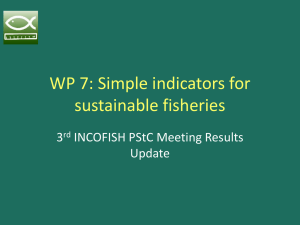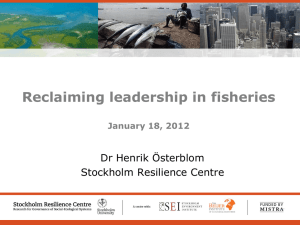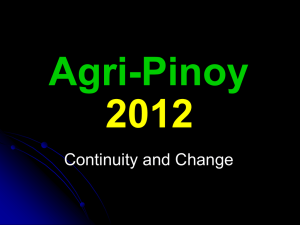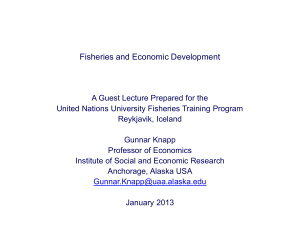Power Point - Primary Industry and Fisheries
advertisement
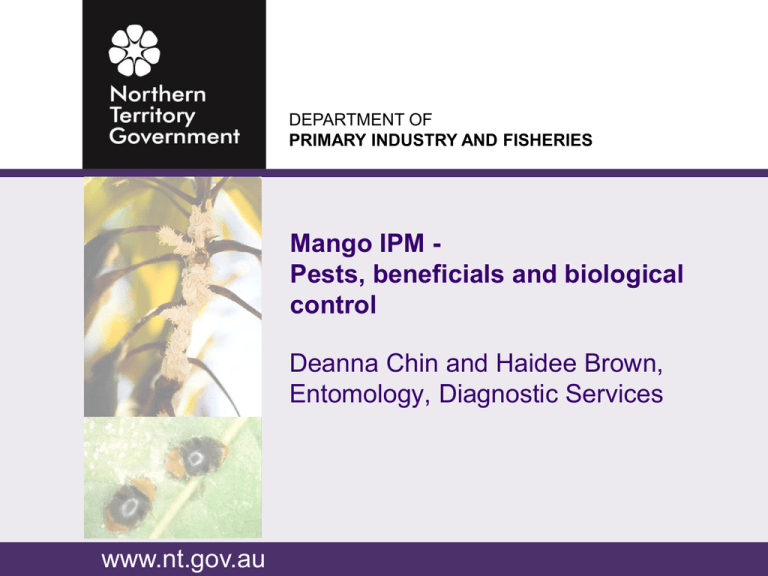
DEPARTMENT OF PRIMARY INDUSTRY AND FISHERIES Mango IPM Pests, beneficials and biological control Deanna Chin and Haidee Brown, Entomology, Diagnostic Services www.nt.gov.au Chewing Insects • Mango tip borers • Flower caterpillars • Mango stem miner • Swarming beetles • Longicorn borer • Mango seed weevil • Giant termite DEPARTMENT OF PRIMARY INDUSTRY AND FISHERIES www.nt.gov.au Large mango tip borer • Mature larvae: 25 mm • Life cycle: about 35 days (larval dev 8-10 days) • Larvae feed at night DEPARTMENT OF PRIMARY INDUSTRY AND FISHERIES www.nt.gov.au Flower caterpillars • Mature larvae: up to 15 mm • Life cycle: 3-4 weeks DEPARTMENT OF PRIMARY INDUSTRY AND FISHERIES www.nt.gov.au Mango stem miner • Larval length: a few mm • Life cycle: 3-4 weeks DEPARTMENT OF PRIMARY INDUSTRY AND FISHERIES www.nt.gov.au Swarming beetles Geloptera sp. Rhyparida sp. • Various swarming beetles: 3-6 mm in length Monolepta sp. DEPARTMENT OF PRIMARY INDUSTRY AND FISHERIES www.nt.gov.au Longicorn borer ● Mature larvae: up to 40 mm ● Adult length: 20-30 mm ● One generation per year DEPARTMENT OF PRIMARY INDUSTRY AND FISHERIES www.nt.gov.au Mango seed weevil Feeding damage to fruit • Adult length 10 mm • 1 generation per year • Fruit are infested when they are 30 mm in diametre DEPARTMENT OF PRIMARY INDUSTRY AND FISHERIES www.nt.gov.au Giant termite • Workers and soldiers: 10-12 mm • Life cycle: up to 1 year DEPARTMENT OF PRIMARY INDUSTRY AND FISHERIES www.nt.gov.au Sap feeding insects • Mango leafhopper • Mealybugs and fluted scales • Mango planthopper (flatids) • Mango scale • Fruit spotting bug • Pink wax scale • Tea mosquito bug • Graptostethus • Dimpling bug • Redbanded thrips • Flower thrips (these are also pollinators) DEPARTMENT OF PRIMARY INDUSTRY AND FISHERIES www.nt.gov.au Mango leafhopper • Adult: 4-5 mm in length • Complete life cycle: 12-20 days DEPARTMENT OF PRIMARY INDUSTRY AND FISHERIES www.nt.gov.au Mango planthopper • Adult length: 10-15 mm • Complete life cycle:12-16 days DEPARTMENT OF PRIMARY INDUSTRY AND FISHERIES www.nt.gov.au Fruit spotting bug • Adult: 15 mm in length • About 5 generations per year DEPARTMENT OF PRIMARY INDUSTRY AND FISHERIES www.nt.gov.au Tea mosquito bug • Adult length: 6-7 mm • Life cycle: 4 weeks DEPARTMENT OF PRIMARY INDUSTRY AND FISHERIES www.nt.gov.au Graptostethus • Adult length: 7-9 mm • Life cycle period unknown DEPARTMENT OF PRIMARY INDUSTRY AND FISHERIES www.nt.gov.au Dimpling bug • Adult length: 2.5 mm • Life cycle: 2 weeks DEPARTMENT OF PRIMARY INDUSTRY AND FISHERIES www.nt.gov.au Redbanded thrips • Adult length: 1.3 mm • Life cycle: 2-3 weeks DEPARTMENT OF PRIMARY INDUSTRY AND FISHERIES www.nt.gov.au Scirtothrips •Adult length: about 1 mm •Life cycle: about 21 days DEPARTMENT OF PRIMARY INDUSTRY AND FISHERIES www.nt.gov.au Fluted scales and mealybugs Fluted scales Mealybugs • Adult length varies according to species e.g. Fluted scales 3-8 mm DEPARTMENT OF PRIMARY INDUSTRY AND FISHERIES www.nt.gov.au Mango scale • Adult length: 1-2 mm • 5 generations per year DEPARTMENT OF PRIMARY INDUSTRY AND FISHERIES www.nt.gov.au Pink wax scale • Adult length: 3-4 mm DEPARTMENT OF PRIMARY INDUSTRY AND FISHERIES www.nt.gov.au Fruit flies Bactrocera tryoni Bactrocera jarvisi • Adult length: 910 mm • Life cycle: about 3-4 weeks Fruit fly larva Sting mark on fruit DEPARTMENT OF PRIMARY INDUSTRY AND FISHERIES www.nt.gov.au Mango bud mite Other eriophyid mites are associated with silvery-white wax on leaves • Adult length: 0.25 mm • Life cycle: 6 days DEPARTMENT OF PRIMARY INDUSTRY AND FISHERIES www.nt.gov.au Quarantine pests Mango seed weevil Mango pulp weevil • Mango pulp weevil Larvae tunnel into pulp Present in SE Asia DEPARTMENT OF PRIMARY INDUSTRY AND FISHERIES www.nt.gov.au Quarantine pests Red banded mango caterpillar • Larvae tunnel through flesh and skin and feed on seed • Detected in the Torres Strait & the tip of Cape York DEPARTMENT OF PRIMARY INDUSTRY AND FISHERIES www.nt.gov.au Quarantine pests Mango gall midge • Damages fruit and leaves • Many species • Present in the Torres Strait • Major pest in some Asian countries DEPARTMENT OF PRIMARY INDUSTRY AND FISHERIES www.nt.gov.au Quarantine pests • • Exotic fruit flies Various detections over the years Mediterranean fruit fly Philippines fruit fly DEPARTMENT OF PRIMARY INDUSTRY AND FISHERIES www.nt.gov.au Native beneficial insects • Pollinators • Praying mantises • Ladybird beetles • Spiders • Hoverfly larvae • Wasp parasites • Lacewings • Insect pathogens e.g. fungal infections, viruses and bacteria • Epipyropid moth DEPARTMENT OF PRIMARY INDUSTRY AND FISHERIES www.nt.gov.au Pollinators Blowfly Honey bee Bush fly Hover fly Bush bee DEPARTMENT OF PRIMARY INDUSTRY AND FISHERIES www.nt.gov.au General Predator Captures and feeds on a large range of insects. Praying mantis DEPARTMENT OF PRIMARY INDUSTRY AND FISHERIES www.nt.gov.au Spiders - General Predators Captures and feeds on a large range of insects. DEPARTMENT OF PRIMARY INDUSTRY AND FISHERIES www.nt.gov.au Natural enemies of planthoppers Epipyropid moth and pupa Fungal pathogen DEPARTMENT OF PRIMARY INDUSTRY AND FISHERIES www.nt.gov.au Hoverfly larva Hover fly larva feeding on mango scale DEPARTMENT OF PRIMARY INDUSTRY AND FISHERIES www.nt.gov.au Commercially produced beneficials • The following predators have been released and observed in mango orchards in the NT: • Mealybug ladybird, Cryptolaemus montrouzeri - this species is also native to the NT. The beetle can become well established (if orchard is suitable) and is effective in controlling mealybugs. Cryptolaemus adults Cryptolaemus adult and larva DEPARTMENT OF PRIMARY INDUSTRY AND FISHERIES www.nt.gov.au Commercially produced beneficials Green lacewing larvae, Mallada signata • general predator, feeds on small insects or eggs e.g. scales, mealybugs, moth eggs and caterpillars. May be difficult to monitor after release. Check leaves for eggs on stalks. DEPARTMENT OF PRIMARY INDUSTRY AND FISHERIES www.nt.gov.au Commercially produced beneficials Available from the supplier: Bugs for Bugs www.bugsforbugs.com.au Before releasing predators: Determine if your orchard has suitable habitats for the predators to establish e.g. does it have shade and access to water. Orchards 5 years or older are generally more suitable than younger orchards. Also the rate of release needs to be discussed with the supplier. DEPARTMENT OF PRIMARY INDUSTRY AND FISHERIES www.nt.gov.au Ants Are they pests or beneficials? DEPARTMENT OF PRIMARY INDUSTRY AND FISHERIES www.nt.gov.au

